Insights into Public Visual Behaviors through Eye-Tracking Tests: A Study Based on National Park System Pilot Area Landscapes
Abstract
1. Introduction
2. Materials and Methods
2.1. Background
2.2. Method
2.3. Procedures
2.3.1. Sample Materials and Processing
2.3.2. Selection of Subjects
2.3.3. Eye-Tracking Test
2.3.4. Selection of Eye-Tracking Indexes
2.4. Data Processing
3. Results
3.1. Eye-Tracking Data for Different Landscape Types in the Pilot Area
3.2. Eye-Tracking Data for Different Color Diversities of Landscapes in the Pilot Area
3.3. Eye-Tracking Data for Different Degrees of Spatial Confinement of Landscapes in the Pilot Area
4. Discussion
4.1. Effects of Landscape Type in the Pilot Area on Public Visual Behaviors
4.2. Effects of Color Diversity of Landscapes in the Pilot Area on Public Visual Behaviors
4.3. Effects of Spatial Confinement of the Landscape in the Pilot Area on Public Visual Behaviors
4.4. Effects of Group Characteristics on Visual Preferences
5. Conclusions
Author Contributions
Funding
Acknowledgments
Conflicts of Interest
Appendix A
| Eye-Tracking Indexes | Landscape Groups | Gender | Average | Sig. | Place of Origin | Average | Sig. | Major | Average | Sig. |
|---|---|---|---|---|---|---|---|---|---|---|
| FDA (ms) | Color diversity group | Male | 204.847 | 0.722 | ER | 197.367 | 0.564 | FM | 209.689 | 0.031 |
| Female | 208.562 | CR | 215.732 | AM | 222.350 | |||||
| WR | 208.696 | OM | 184.130 | |||||||
| Color neutral group | Male | 207.992 | 0.332 | ER | 204.561 | 0.012 | FM | 221.630 | 0.000 | |
| Female | 216.835 | CR | 212.752 | AM | 225.486 | |||||
| WR | 244.427 | OM | 182.336 | |||||||
| Color unity group | Male | 224.083 | 0.445 | ER | 220.843 | 0.097 | FM | 236.473 | 0.001 | |
| Female | 231.609 | CR | 239.339 | AM | 241.220 | |||||
| WR | 217.794 | OM | 198.458 | |||||||
| SVA (°/s) | Color diversity group | Male | 92.506 | 0.074 | ER | 93.647 | 0.169 | FM | 100.912 | 0.862 |
| Female | 108.728 | CR | 109.761 | AM | 104.847 | |||||
| WR | 104.573 | OM | 100.875 | |||||||
| Color neutral group | Male | 92.943 | 0.001 | ER | 94.123 | 0.047 | FM | 100.972 | 0.077 | |
| Female | 106.099 | CR | 108.087 | AM | 106.372 | |||||
| WR | 103.745 | OM | 96.568 | |||||||
| Color unity group | Male | 89.481 | 0.000 | ER | 91.993 | 0.004 | FM | 104.560 | 0.109 | |
| Female | 110.709 | CR | 109.050 | AM | 107.891 | |||||
| WR | 120.452 | OM | 96.180 | |||||||
| SF (count/s) | Color diversity group | Male | 0.722 | 0.550 | ER | 0.635 | 0.017 | FM | 0.754 | 0.000 |
| Female | 0.689 | CR | 0.799 | AM | 0.810 | |||||
| WR | 0.616 | OM | 0.475 | |||||||
| Color neutral group | Male | 0.679 | 0.185 | ER | 0.642 | 0.000 | FM | 0.769 | 0.000 | |
| Female | 0.736 | CR | 0.818 | AM | 0.787 | |||||
| WR | 0.623 | OM | 0.529 | |||||||
| Color unity group | Male | 0.608 | 0.200 | ER | 0.565 | 0.034 | FM | 0.691 | 0.000 | |
| Female | 0.663 | CR | 0.721 | AM | 0.695 | |||||
| WR | 0.620 | OM | 0.491 |
| Eye-Tracking Indexes | Landscape Groups | Gender | Average | Sig. | Place of Origin | Average | Sig. | Major | Average | Sig. |
|---|---|---|---|---|---|---|---|---|---|---|
| FDA (ms) | Spatial confined group | Male | 216.622 | 0.204 | ER | 219.409 | 0.732 | FM | 223.913 | 0.000 |
| Female | 226.759 | CR | 224.599 | AM | 241.938 | |||||
| WR | 229.075 | OM | 195.072 | |||||||
| Spatial semi-confined group | Male | 207.385 | 0.391 | ER | 194.183 | 0.018 | FM | 229.173 | 0.001 | |
| Female | 217.500 | CR | 225.003 | AM | 215.688 | |||||
| WR | 237.244 | OM | 183.596 | |||||||
| Spatial open group | Male | 208.873 | 0.712 | ER | 201.736 | 0.780 | FM | 213.483 | 0.006 | |
| Female | 204.441 | CR | 206.939 | AM | 221.089 | |||||
| WR | 214.635 | OM | 174.846 | |||||||
| SVA (°/s) | Spatial confined group | Male | 86.512 | 0.000 | ER | 90.814 | 0.000 | FM | 103.492 | 0.021 |
| Female | 108.944 | CR | 107.358 | AM | 103.836 | |||||
| WR | 113.056 | OM | 93.942 | |||||||
| Spatial semi-confined group | Male | 100.495 | 0.124 | ER | 98.808 | 0.386 | FM | 99.744 | 0.074 | |
| Female | 108.577 | CR | 112.124 | AM | 113.942 | |||||
| WR | 105.712 | OM | 105.069 | |||||||
| Spatial open group | Male | 90.804 | 0.136 | ER | 90.829 | 0.167 | FM | 102.184 | 0.421 | |
| Female | 104.755 | CR | 106.503 | AM | 100.847 | |||||
| WR | 103.834 | OM | 93.060 | |||||||
| SF (count/s) | Spatial confined group | Male | 0.663 | 0.156 | ER | 0.610 | 0.001 | FM | 0.746 | 0.000 |
| Female | 0.719 | CR | 0.792 | AM | 0.762 | |||||
| WR | 1.660 | OM | 0.519 | |||||||
| Spatial semi-confined group | Male | 0.694 | 0.839 | ER | 0.625 | 0.018 | FM | 0.758 | 0.000 | |
| Female | 0.683 | CR | 0.778 | AM | 0.756 | |||||
| WR | 0.599 | OM | 0.495 | |||||||
| Spatial open group | Male | 0.628 | 0.164 | ER | 0.622 | 0.006 | FM | 0.704 | 0.000 | |
| Female | 0.704 | CR | 0.779 | AM | 0.784 | |||||
| WR | 0.556 | OM | 0.493 |
References
- Borrini-Feyerabend, G.; Dudley, N.; Jaeger, T.; Lassen, B.; Pathak Broome, N.; Phillips, A.; Sandwith, T. Governance of Protected Areas: From Understanding to Action; IUCN: Gland, Switzerland, 2013; pp. 10–29. [Google Scholar]
- Huang, B.R.; Wang, Y.; Su, L.Y.; Zhang, C.L.; Cheng, D.W.; Sun, J.; He, S.Y. Pilot Programs for National Park System in China: Progress, Problems and Recommendations. Bull. Chin. Acad. Sci. 2018, 33, 76–85. (In Chinese) [Google Scholar]
- Collen, B. Conservation prioritization in the context of uncertainty. Anim. Conserv. 2015, 18, 315–317. [Google Scholar] [CrossRef]
- Brown, G.; Hausner, V.H.; Grodzińska-Jurczak, M.; Pietrzyk-Kaszyńska, A. Cross-cultural values and management preferences in protected areas of Norway and Poland. J. Nat. Conserv. 2015, 28, 89–104. [Google Scholar] [CrossRef]
- Speed, J.M.; Austrhein, G.; Birksbcd, H.J.; Johnson, S.M.; Kvamme, M.; Nagy, L.; Sjögren, P.; Skar, B.; Stone, D.; Svensson, E.; et al. Natural and cultural heritage in mountain landscapes: Towards an integrated valuation. Int. J. Biodivers. Sci. Ecosyst. Serv. Manag. 2012, 8, 313–320. [Google Scholar] [CrossRef]
- Zhao, J.Z.; Liu, X.; Dong, R.C.; Shao, G.F. Landsenses ecology and ecological planning toward sustainable development. Int. J. Sustain. Dev. World Ecol. 2016, 23, 293–297. [Google Scholar] [CrossRef]
- Shao, J.; Qiu, Q.; Qian, Y.; Tang, L. Optimal visual perception in land-use planning and design based on landsenses ecology. Int. J. Sustain. Dev. World Ecol. 2020, 27, 233–239. [Google Scholar] [CrossRef]
- Madureira, H.; Nunes, F.; Oliveira, J.V.; Cormier, L.; Madureira, T. Urban residents′beliefs concerning green space benefits in four cities in France and Portugal. Urban. For. Urban. Green. 2015, 14, 56–64. [Google Scholar] [CrossRef]
- Coon, J.T.; Boddy, K.; Stein, K.; Whear, R.; Barton, J.; Depledge, M.H. Does participating in physical activity in outdoor natural environments have a greater effect on physical and mental wellbeing than physical activity indoors? A systematic review. Environ. Sci. Technol. 2011, 45, 1761–1772. [Google Scholar] [CrossRef] [PubMed]
- Fu, B.J.; Li, Y. Bidirectional coupling between the Earth and human systems is essential for modeling sustainability. Natl. Sci. Rev. 2016, 3, 397–398. [Google Scholar] [CrossRef]
- Fu, B.J.; Forsius, M. Ecosystem services modeling in contrasting landscapes. Landsc. Ecol. 2015, 30, 375–379. [Google Scholar] [CrossRef]
- Sutherland, W.J.; Freckleton, R.P.; Godfray, H.C.; Beissinger, S.R.; Benton, T.; Cameron, D.D.; Carmel, Y.; Coomes, D.A.; Coulson, T.; Emmerson, M.C. Identification of 100 fundamental ecological questions. J. Ecol. 2013, 101, 58–67. [Google Scholar] [CrossRef]
- Cabana, D.; Ryfield, F.; Crowe, T.P.; Brannigan, J. Evaluating and communicating cultural ecosystem services. Ecosyst. Serv. 2020, 42. [Google Scholar] [CrossRef]
- Tang, L.N.; Li, J.; Qiu, Q.Y.; Shi, L.Y.; Wang, H.W.; Zheng, S.N. Review of methods and practices of landsenses ecology. Actaecologica Sin. 2020, 40, 8015–8021. (In Chinese) [Google Scholar]
- Gobster, P.H.; Nassauer, J.I.; Daniel, T.C.; Fry, G. The Shared Landscape: What does Aesthetics Have to do with Ecology? Landsc. Ecol. 2007, 22, 959–972. [Google Scholar] [CrossRef]
- Mallarch, J.M. Values of Protected Landscapes and Seascapes: Protected Landscapes and Cultural and Spiritual Values; GTZ, IUCN and Obra Social de Caixa Catalunya: Heidelberg, Germany, 2008; pp. 9–20. [Google Scholar]
- Agnolett, M. Rural landscape, nature conservation and culture: Some notes on research trends and management approaches from a (Southern) European perspective. Landsc. Urban. Plan. 2014, 126, 66–73. [Google Scholar] [CrossRef]
- Zhou, N.X.; Huang, Z.F.; Jiang, M.P.; Liang, Y.Y. The relationships between forest landscape visual quality and landscape spatial pattern index of Mount Lushan. Geogr. Res. 2012, 31, 1224–1232. (In Chinese) [Google Scholar]
- Chang Chien, Y.M.; Carver, S.; Comber, A. An Exploratory Analysis of Expert and Nonexpert-Based Land-Scape Aesthetics Evaluations: A Case Study from Wales. Land 2021, 10, 192. [Google Scholar] [CrossRef]
- Vukomanovic, J.; Orr, B.J. Landscape Aesthetics and the Scenic Drivers of Amenity Migration in the New West: Naturalness, Visual Scale, and Complexity. Land 2014, 3, 390–413. [Google Scholar] [CrossRef]
- Dramstad, W.E.; Tveit, M.S.; Fjellsta, W.; Fry, G. Relationships between visual landscape preferences and mapbased indicators of landscape structure. Landsc. Urban. Plan. 2006, 78, 465–474. [Google Scholar] [CrossRef]
- Yang, Y.; Tang, X.L. The Evaluation and Factor Analysis of the Visual Quality of Scenic Forest Landscape:A Case Study of Purple Mountain National Forest Park in Nanjing. Chin. Landsc. Archit. 2020, 36, 135–140. (In Chinese) [Google Scholar]
- Meo, I.D.; Cantiani, P.; Paletto, A. Effect of Thinning on Forest Scenic Beauty in a Black Pine Forest in Central Italy. Forests 2020, 11, 1295. [Google Scholar] [CrossRef]
- Liu, Y.P.; Hu, M.J.; Zhao, B. Audio-visual interactive evaluation of the forest landscape based on eye-tracking experiments. Urban. For. Urban. Green. 2019, 46, 126476. [Google Scholar] [CrossRef]
- Zhang, W.D.; Fang, H.L.; Zhang, D.S.; Zhang, Q.F. An Assessment of City Greening Langscape Appreciation. Psychol. Sci. 2008, 4, 823–826. (In Chinese) [Google Scholar]
- Dupont, L.; Antrop, M.; Van Eetvelde, V. Does landscape related expertise influence the visual perception of landscape photographs? Implications for participatory landscape planning and management. Landsc. Urban Plan. 2015, 141, 68–77. [Google Scholar] [CrossRef]
- Zhao, Y.; Lin, J.H.; Liu, Y. Research on visual evaluation of tourism scenery based on eye movement experiment:a case of tangjia ancient town in zhuhai. Hum. Geogr. 2020, 35, 130–140. (In Chinese) [Google Scholar]
- Nordh, H.; Hagerhall, C.M.; Holmqvist, K. Tracking restorative components:Patterns in eye movements as a consequence of a restorative rating task. Landsc. Res. 2013, 38, 101–116. [Google Scholar] [CrossRef]
- Zhang, Z. Study on Forest Color Characteristics and Its Influence Based on Public Response Evaluation—A Case Study of Autumn Forest in Jiuzhaigou, Sichuan Province; Chinese Academy of Forestry: Beijing, China, 2017. (In Chinese) [Google Scholar]
- Xiaoting, H.; Wenxuan, L. An experimental study on eye movement. Tour. Guide 2017, 1, 91–95. [Google Scholar]
- Zhang, J. Investigation Analysis and Practice in Planning and Design; Architecture and Building Press: Beijing, China, 2005. (In Chinese) [Google Scholar]
- Yu, Z.Y.; Liu, Y. Reflection and prospect of the application of eye movement experiment in tourism psychology research. Tour. Trib. 2020, 3, 7–8. (In Chinese) [Google Scholar]
- Duffy, A.M. Two-way street: How smartphones and the social web impact the traveller’s liminal gaze. Mob. Media Commun. 2018, 7, 60–75. [Google Scholar] [CrossRef]
- Dong, W.H.; Liao, H.; Zhan, Z.C.; Liu, B.; Wang, S.K.; Yang, T.Y. New research progress of eye tracking-based map cognition in cartography since 2008. Acta Geogr. Sin. 2019, 74, 599–614. [Google Scholar]
- Ghi, C.F.; Lin, Y.H.; Lan, W.S. Measurement of information processing load and visual load on a dynamic information processing task. Behav. Inf. Technol. 2003, 22, 365–374. [Google Scholar]
- Wu, Y.Y.; Liu, Y.Q.; Tsai, R.; Yau, S.T. Investigating the role of eye movements and physiological signals in search satisfaction prediction using geometric analysis. J. Assoc. Inf. Sci. Technol. 2019, 7, 981–999. [Google Scholar] [CrossRef]
- Scott, N.; Le, D.; Becken, S.; Connolly, R.M. Measuring perceived beauty of the Great Barrier Reef using eyetracking technology. Curr. Issues Tour. 2019, 23, 2492–2502. [Google Scholar]
- Yan, G.L.; Bai, X.J. Eye Movement Analyses in Advertisement Psychology and Its Research Trend. Psychol. Sci. 2004, 2, 459–461. (In Chinese) [Google Scholar]
- Li, Y.; Gao, X.H.; Huang, J.X.; Wu, M. Visual Behavior Analysis of Tourists Based on Photography and Eye-tracking Experiment—A Case of Xiamen University. Tour. Trib. 2020, 35, 41–52. (In Chinese) [Google Scholar]
- Gong, Y.; Zhang, S.Y.; Liu, Z.F.; Shen, F. Eye movement study on color effects to icon visual search efficiency. J. Zhejiang Univ. 2016, 50, 1987–1994. (In Chinese) [Google Scholar]
- Li, X.Q.; Zhao, N.X.; Wang, C.Z.; Wang, M.; Huang, H. A preliminary study on the application of eye tracker to the landmark landscape of campus tourism—Taking the north building of Nanjing University as an example. Acta Agric. Jiangxi 2011, 23, 148–151. (In Chinese) [Google Scholar]
- Li, Q.; Huang, Z.J.; Christianson, K. Visual attention toward tourism photographs with text:an eye tracking study. Tour. Manag. 2016, 54, 243–258. [Google Scholar] [CrossRef]
- Guo, S.L. Research on Visual Perception and Assessment of Mountain Landscape in Eastern China Based on Eye Movement; Nanjing University: Nanjing, China, 2018. (In Chinese) [Google Scholar]
- Stephenson, J. The Cultural Values Model: An integrated approach to values in landscapes. Landsc. Urban Plan. 2008, 84, 127–139. [Google Scholar] [CrossRef]
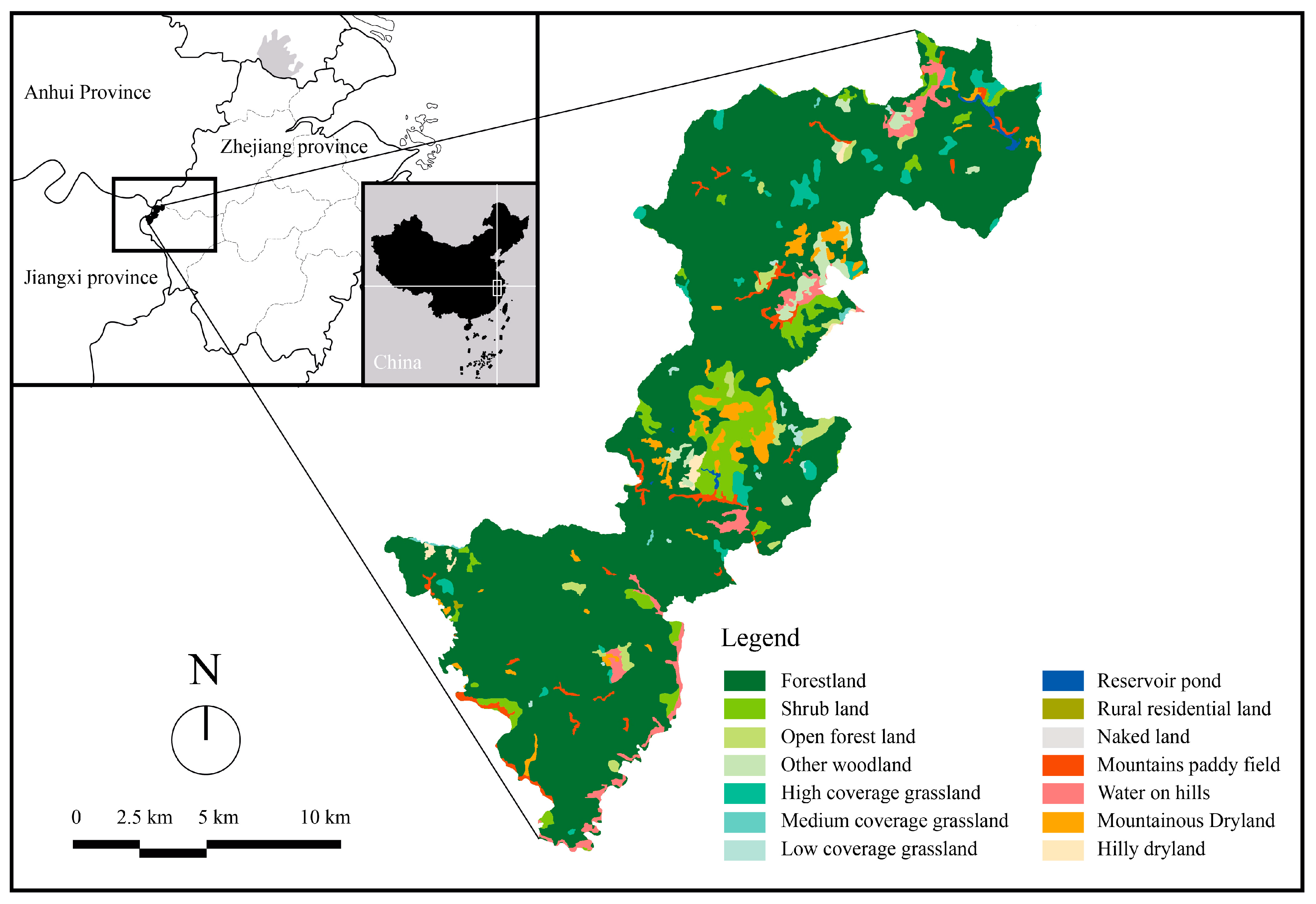
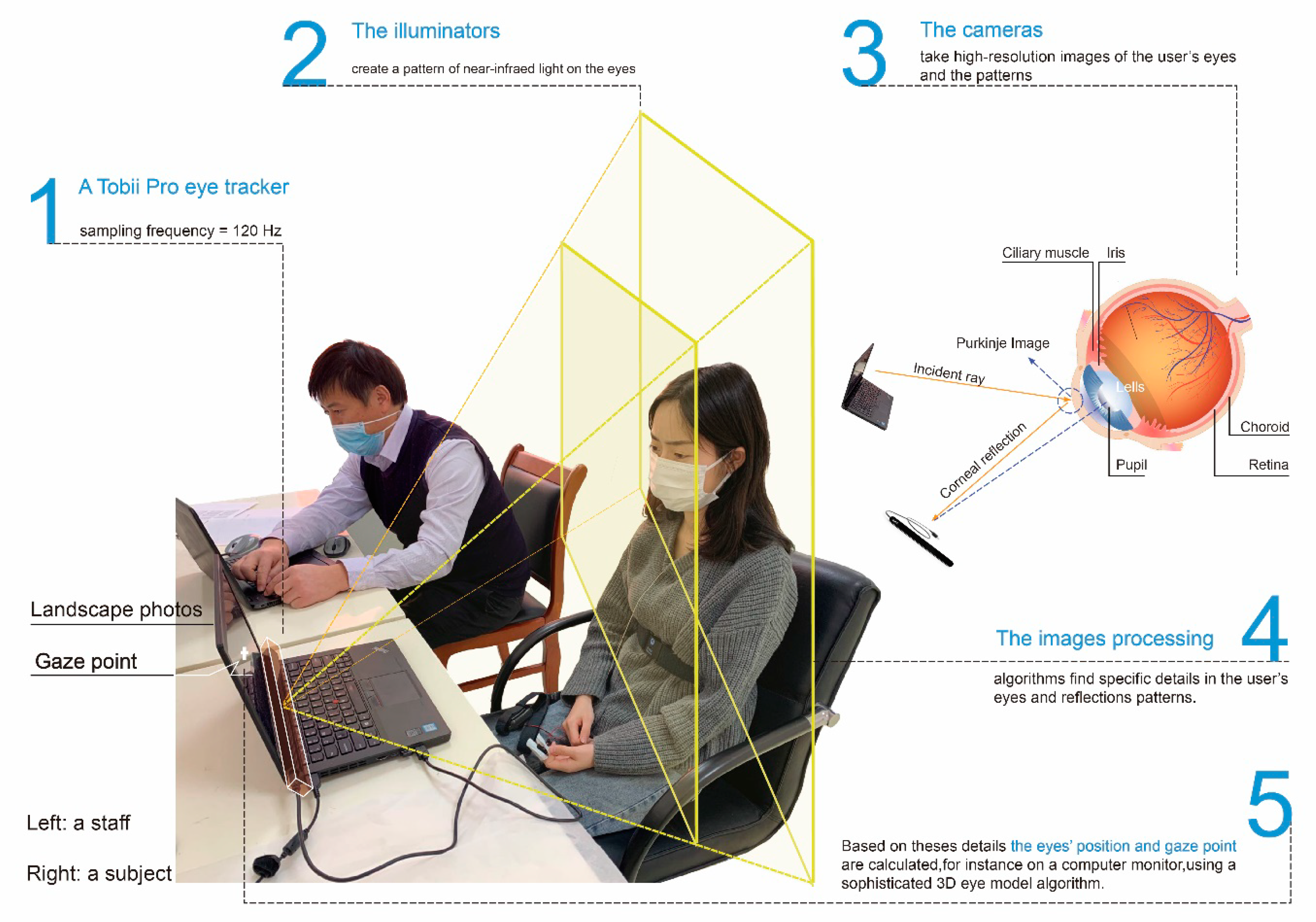
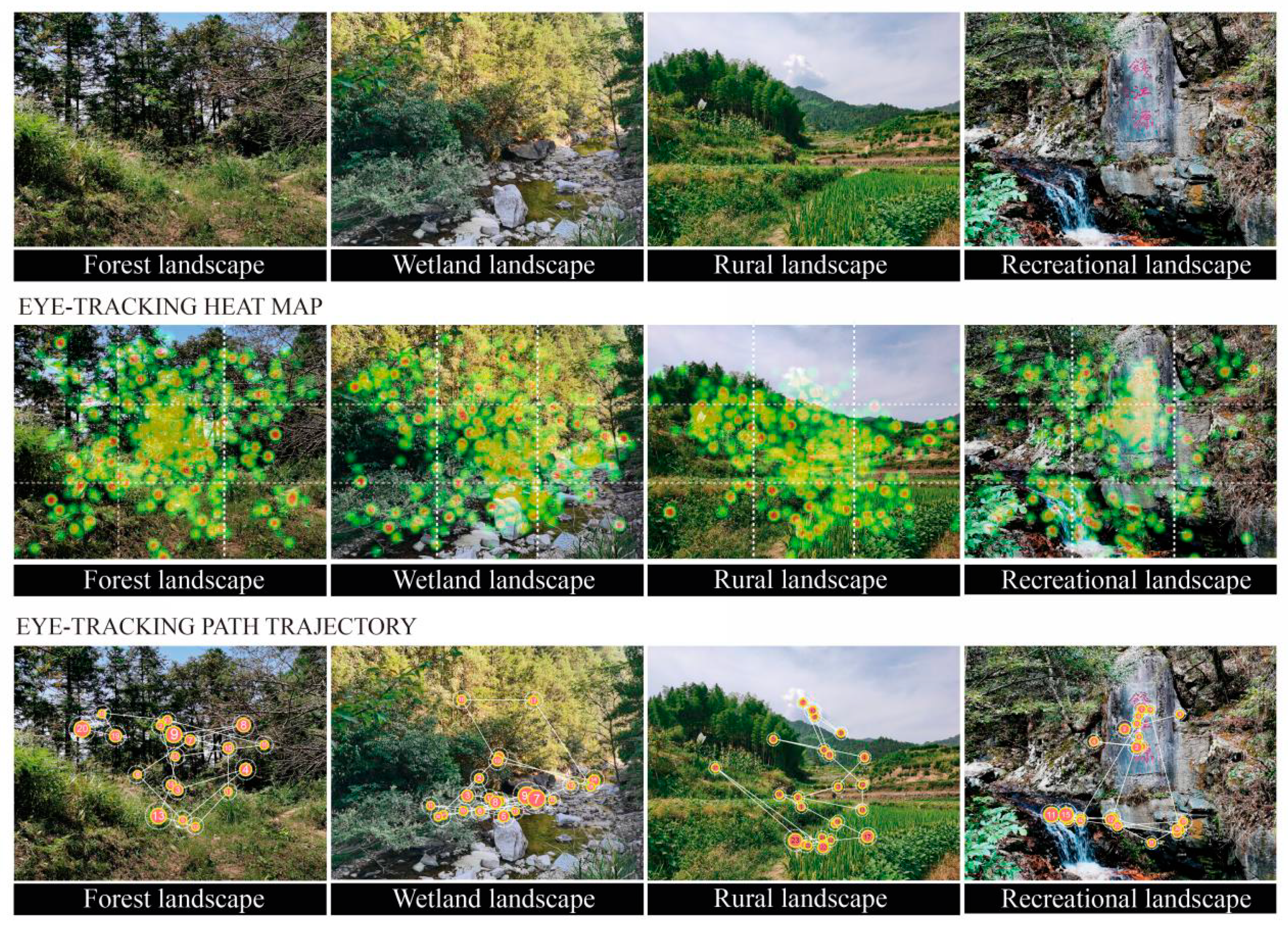
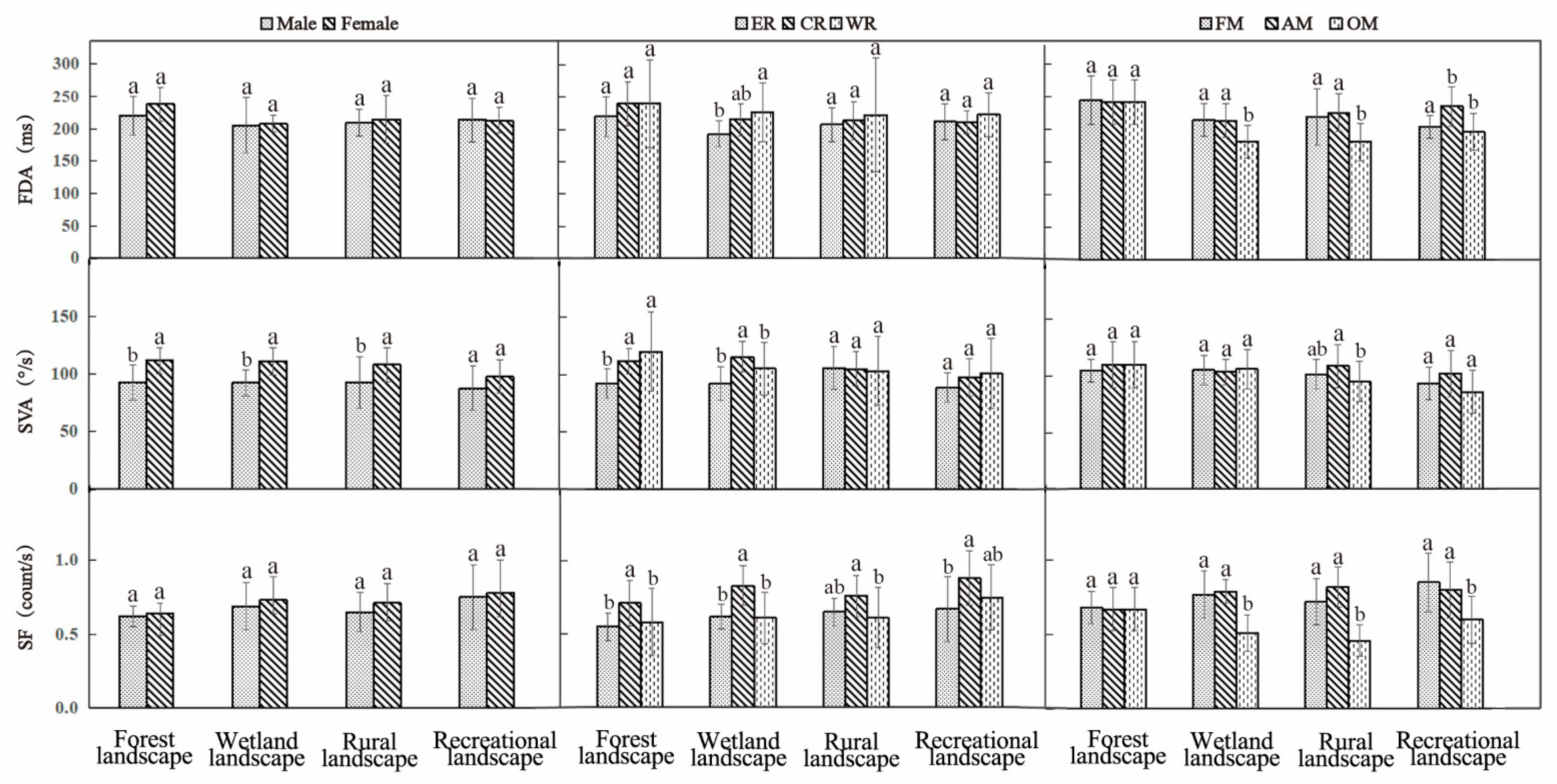
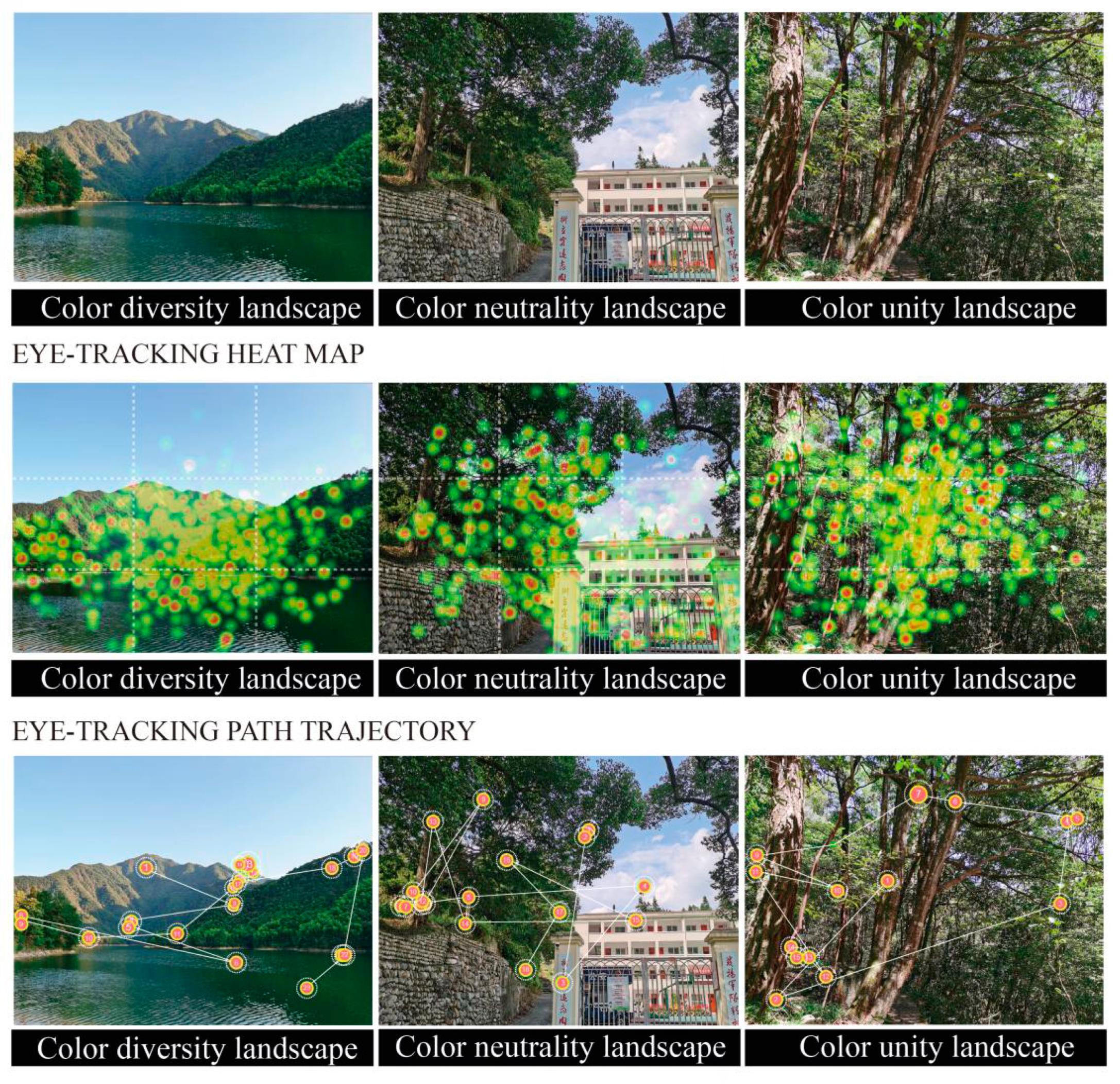
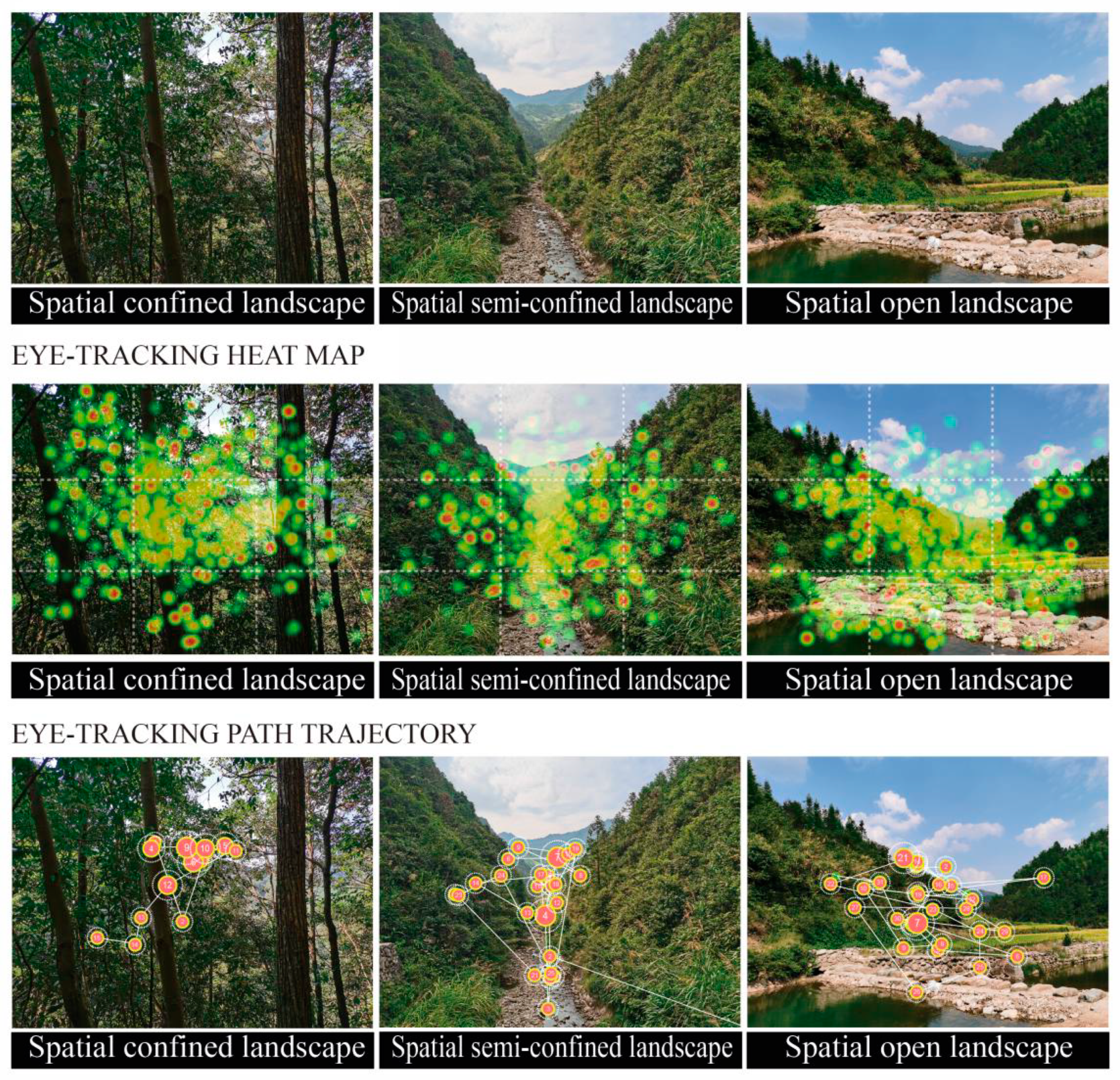
| Index | Score & Adjectives | Description |
|---|---|---|
| Color diversities of landscapes |  | Is the color of landscape reflected in this picture diverse or unified? |
| Degrees of spatial confinement of the landscape |  | Is the landscape space reflected in this picture closed or open? |
| Project | Group | Number of Subjects | Percentage (%) |
|---|---|---|---|
| Gender | Male | 25 | 39% |
| Female | 39 | 61% | |
| Education level | Undergraduate | 26 | 41% |
| Master’s degree candidate | 34 | 53% | |
| Doctoral candidate | 4 | 6% | |
| Place of origin | Eastern region | 29 | 45% |
| Central region | 11 | 17% | |
| Western region | 24 | 38% | |
| Major | Art major | 19 | 30% |
| Forestry major | 26 | 40% | |
| Other major | 19 | 30% |
| Eye-Tracking Index | Abbreviation | Definition and Meaning |
|---|---|---|
| Fixation duration average (ms) | FDA | The index value is obtained by dividing the fixation duration by the number of fixation points, which represents each fixation duration of the subject for the National Park landscape. The longer the FDA is, the harder the subjects tried to understand the landscape of the national park. |
| First fixation duration (ms) | FFD | The duration of the first fixation point in the area of interest, which indicates the first fixation velocity of the subject for the national park landscape. The shorter the FFD is, the faster the national park landscape can attract the attention of the subjects. |
| Saccade velocity average (°/s) | SVA | In the process of saccade, the average value of the peak value of each saccade. This index represents the range of subjects’ access to the landscape information of the national park and reflects the distinctness of the landscape characteristics of the national park. The faster the SVA is, the less attractive the information between fixation points is to the subjects. |
| Saccade amplitude average (°) | SAA | This index reflects the range of the subjects’ access to the landscape information of the national park. When the index is large, the fixation point of the subject can more easily reach the target area. |
| Fixation frequency (count/s) | FF | The ratio of the number of fixations to fixation duration reflects the degree of interest and importance of the fixation area. The greater the FF is, the more interested the subjects were in the national park landscape. |
| Saccade frequency (count/s) | SF | The number of saccades per unit time represents the subject’s visual search behavior for the national park landscape. The larger the SF is, the greater the visual search volume of the subjects, and the less distinctive the national park landscape features. |
| Eye-Tracking Indexes | FDA (ms) | FFD (ms) | SVA (°/s) | SAA (°) | FF (Count/s) | SF (Count/s) |
|---|---|---|---|---|---|---|
| Forest landscape | 231.30 ± 18.22a | 202.67 ± 22.30a | 104.84 ± 8.26a | 2.47 ± 0.21a | 1.40 ± 0.12a | 0.63 ± 0.11b |
| Wetland landscape | 207.02 ± 18.79b | 195.08 ± 19.51a | 104.61 ± 8.15a | 2.46 ± 0.27a | 1.43 ± 0.15a | 0.71 ± 0.09ab |
| Rural landscape | 212.45 ± 26.04b | 196.56 ± 33.74a | 102.45 ± 12.26ab | 2.42 ± 0.35ab | 1.38 ± 0.16a | 0.69 ± 0.11ab |
| Recreational landscape | 213.06 ± 20.10b | 203.26 ± 35.32a | 94.30 ± 14.78b | 2.19 ± 0.46b | 1.49 ± 0.13a | 0.77 ± 0.17a |
| FFD | SVA | SAA | FF | SF | |
|---|---|---|---|---|---|
| FDA | 0.640 ** | 0.240 | 0.269 | 0.202 | 0.110 |
| FFD | 0.217 | 0.254 | 0.275 * | 0.215 | |
| SVA | 0.959 ** | 0.205 | 0.170 | ||
| SAA | 0.247 | 0.218 | |||
| FF | 0.802 ** |
| Eye Tracking Indexes | FDA (ms) | FFD (ms) | SVA (°/s) | SAA (°) | FF (Count/s) | SF (Count/s) |
|---|---|---|---|---|---|---|
| Color diversity group | 207.30 ± 22.36b | 187.09 ± 27.59a | 102.44 ± 13.66a | 2.43 ± 0.42a | 1.39 ± 0.16a | 0.70 ± 0.11a |
| Color neutral group | 213.47 ± 23.14b | 199.17 ± 27.54a | 101.60 ± 11.11a | 2.37 ± 0.34a | 1.43 ± 0.15a | 0.72 ± 0.14a |
| Color unity group | 228.77 ± 17.79a | 207.41 ± 23.94a | 103.53 ± 9.50a | 2.44 ± 0.25a | 1.41 ± 0.12a | 0.64 ± 0.10a |
| Eye Tracking Indexes | FDA (ms) | FFD (ms) | SVA (°/s) | SAA (°) | FF (count/s) | SF (count/s) |
|---|---|---|---|---|---|---|
| Spatial confined group | 223.02 ± 20.76a | 211.01 ± 26.14a | 101.37 ± 10.27a | 2.38 ± 0.29a | 1.46 ± 0.12a | 0.70 ± 0.13a |
| Spatial semi-confined group | 213.67 ± 24.54ab | 190.20 ± 20.07b | 105.51 ± 11.20a | 2.48 ± 0.33a | 1.39 ± 0.15a | 0.69 ± 0.14a |
| Spatial open group | 205.98 ± 21.10b | 183.54 ± 27.64b | 99.58 ± 12.58a | 2.36 ± 0.41a | 1.38 ± 0.16a | 0.68 ± 0.11a |
Publisher’s Note: MDPI stays neutral with regard to jurisdictional claims in published maps and institutional affiliations. |
© 2021 by the authors. Licensee MDPI, Basel, Switzerland. This article is an open access article distributed under the terms and conditions of the Creative Commons Attribution (CC BY) license (https://creativecommons.org/licenses/by/4.0/).
Share and Cite
Wang, P.; Yang, W.; Wang, D.; He, Y. Insights into Public Visual Behaviors through Eye-Tracking Tests: A Study Based on National Park System Pilot Area Landscapes. Land 2021, 10, 497. https://doi.org/10.3390/land10050497
Wang P, Yang W, Wang D, He Y. Insights into Public Visual Behaviors through Eye-Tracking Tests: A Study Based on National Park System Pilot Area Landscapes. Land. 2021; 10(5):497. https://doi.org/10.3390/land10050497
Chicago/Turabian StyleWang, Peng, Wenjuan Yang, Dengju Wang, and Youjun He. 2021. "Insights into Public Visual Behaviors through Eye-Tracking Tests: A Study Based on National Park System Pilot Area Landscapes" Land 10, no. 5: 497. https://doi.org/10.3390/land10050497
APA StyleWang, P., Yang, W., Wang, D., & He, Y. (2021). Insights into Public Visual Behaviors through Eye-Tracking Tests: A Study Based on National Park System Pilot Area Landscapes. Land, 10(5), 497. https://doi.org/10.3390/land10050497





